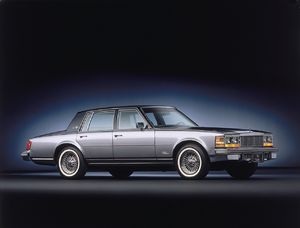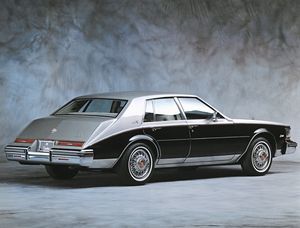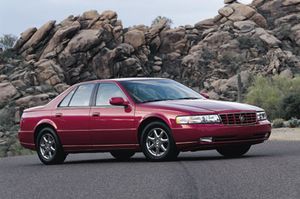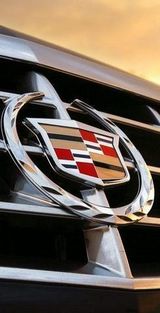.
Cadillac Seville: Difference between revisions
| Line 257: | Line 257: | ||
There would be an all-new Seville for 1992. | There would be an all-new Seville and STS for 1992. | ||
{{-}} | {{-}} | ||
Revision as of 12:41, 7 February 2009

| |
| Cadillac Seville | |
|---|---|
| Cadillac | |
| Production | 1976-1979 |
| Class | Compact/Intermediate |
| Body Style | 4 Door Sedan |
| Length | 204" |
| Width | 71.8" |
| Height | 54.7" |
| Wheelbase | 114.3" |
| Weight | 4100 lbs |
| Transmission | 3-Speed Automatic, RWD |
| Engine | 5.7L (350 cid) V8 (1976-1979) 5.7L (350 cid) diesel V8 (1978-1979) |
| Power | 105-185 hp |
| Platform | K |
Using a name that was previously used for a hardtop edition of the 1956-1960 Cadillac Eldorado model, the Cadillac Seville became a nameplate on its own when it was released in mid-1975 as a 1976 model. Though it was largely based on GM's X-body platform (Buick Skylark, Chevrolet Nova, etc), it was differentiated enough to be given its own unique "K" body designation. This new Seville was Cadillac's answer to the the rising popularity of luxury imports in the USA from Europe, such as Mercedes-Benz and BMW. Historically, these imported luxury cars had been cheaper, less luxurious and significantly smaller than Cadillacs, but over time they had evolved, and had become more luxurious and even more expensive than competing Cadillacs. It became obvious that the traditional American automotive paradigm of "bigger equals better" was no longer in full effect in the marketplace.
The Seville was to be simultaneously the smallest and the most expensive Cadillac in the line-up, turning Cadillac's traditional marketing and pricing strategy on its head. The Seville would undergo several generational transformations during its tenure from 1976-2004 when it was replaced by the STS, an alphanumeric designation that was previously a Euro-inspired option package available for the Seville (Seville Touring Sedan) available since the 1988 model year. The elimination of traditional names for Cadillacs and the subsequent alphanumeric model designations for the line-up was thought to be in keeping with the naming conventions of Cadillac's foreign competitors which universally use alphanumerics for their model nomenclature.
Pre-Production Concepts
The prototypes pictured above show the various styling directions explored by Cadillac prior to the final version that debuted in 1975. It is interesting to note the direction the design took as it evolved, dropping traditional American luxury car styling cues and body proportions in favor of a more compact, less flamboyant final design. Various names for the proposed vehicle were explored as well. Resurection of the LaSalle moniker was seriously considered, but it was decided that given that LaSalle had historically been used for entry-level sub-Cadillacs in the past, it would create confusion in the marketplace among those who recollected the the context of the moniker's earlier usage.
1st Generation (1976-79)
Introduced in the mid-'75 and billed as the new "Internationally-sized" Cadillac, the Seville was almost 1,000 lb (450 kg) lighter and two feet shorter than it's hulking DeVille stablemates, nimble, easy to park, attractive and loaded with the full compliment of Cadillac features. Though more expensive than every other Cadillac model with a base price of $12,479, the Seville was a smash hit and spawned several imitators, such as the less-than-successful Lincoln Versailles, and later the Chrysler LeBaron/Fifth Avenue.
In keeping with it's mission of winning over import-intenders, the Seville was equipped with 4-wheel disc brakes and a tight european-inspired suspension. Under the hood went an Oldsmobile-sourced 350 (5.7L) V8, fitted with Bendix/Bosch electronically controlled fuel injection. This system gave the Seville sure-starts, smooth drivability and performance levels that were lacking in most other cars of the mid-seventies. Power output was 180hp, and performance was restrained but acceptable for that era, with a 0-60mph time of 11.5 seconds. As part of Cadillac's market positioning of the Seville, much equipment that was usually optional on Cadillac's other models were standard on the Seville resulting in even base models being extraordinarily well-equipped and a relatively short available options list in contrast with the prevailing business practices of American domestic automakers at that time.
Given the strong marketplace performance of the very expensive Seville, Cadillac tested the upper reaches of pricing in 1978 by treating the Seville to a new even more up-level $ 2,600.00 "Elegante" trim package, which added a unique two-tone exterior paint combination separated by a stainless steel accent moulding, real wire wheels, a leather-wrapped steering wheel, exclusive perforated leather bucket seats a leather-wrapped steering wheel, and a center console with a folding armrest, a writing tablet, and space for a phone or cassette tapes, extremely plush "Tampico" carpeting and most of Seville's optional equipment as standard. Also in 1978, the 105 hp Oldsmobile 350 diesel V8 engine became available as an option. The diesel at first was fairly popular, but quickly gained a well-deserved reputation for being terribly unreliable and prone to complete catastrophic failure, as well as smelly, noisy, unrefined, and unbelievably slow with a 0-60MPH time approaching 20 seconds.
Another noteworthy 1978 addition was the Seville's optional Delco trip computer. This presaged modern trip computers and could be called upon to provide information on instant fuel mileage, overall fuel mileage, fuel range, and estimated time of arrival, at an additional cost of $ 920.00.
First Generation Production
| Year | 6KS69 Sedan |
|---|---|
| 1976 | 43,772 |
| 1977 | 45,060 |
| 1978 | 56,985 |
| 1979 | 53,487 |
| Total: | 199,304 |
The Seville was replaced by an all-new model for 1980.

|
|||
| Cadillac Seville | |||
|---|---|---|---|
| Cadillac | |||
| Production | 1980-1985 | ||
| Class | Intermediate | ||
| Body Style | 4-Door Sedan | ||
| Length | 204.8" | ||
| Width | 71.2" | ||
| Height | 54.3" | ||
| Wheelbase | 114" | ||
| Weight | 3700-3800 lbs | ||
| Transmission | 3-Speed Automatic, FWD 4-Speed Automatic, FWD | ||
| Engine | 4.1L (250 cid) V8 (1982-1985) 4.1L (252 cid) V6 (1981-1985) 5.7L (350 cid) diesel V8 (1980-1985) 6.0L (368 cid) V8 (1980-1981) 6.0L (368 cid) V8-6-4 (1981) | ||
| Power | 105-140 hp | ||
| Related | Buick Riviera Cadillac Eldorado Oldsmobile Toronado | ||
| Platform | K | ||
2nd Generation (1980-85)
For the 1980 model year, Cadillac moved the Seville to the 114 inch wheelbase front wheel drive K-body platform, based on the E-body that underpinned the Eldorado, Buick Riviera and Oldsmobile Toronado. Returning to some of the original concepts floated for the 1975 edition, stylists created a graceful but controversial bustle-backed body intended to evoke Daimlers of a past era.
Neoclassical styling cues aside, the Seville was a thoroughly modern automobile featuring a fully independent suspension, 4-wheel disc brakes and a host of electronic features such as Electronic on-board vehicle diagnostics, electronic climate control, gas mileage computer, twilight sentinel to name but a few. In 1981 "memory seats", a feature not seen on a Cadillac since the 1957 Eldorado Brougham, became available again. These seats allowed two memorized positions to be recalled at the touch of a button. Also new for '81 was a digital instrument cluster.
The Elegante option package continued to be available with a long list of otherwise optional features as standard as well as exclusive dual front bucket "french-stitched" leather seats, two-tone exterior paint combinations separated by a sweeping stainless steel accent moulding (moulding made standard in 1981 on all Sevilles), a leather-wrapped steering wheel and a center console with a folding armrest, a writing tablet, and space for a phone or cassette tapes, and exclusive "Tampico" carpeting. Pricing for the Elegante package topped out at $ 3,995.00 in 1985.
Upon the second generation Seville's introduction the The Oldsmobile 350 V8 diesel engine was standard, but the buying public was already turning away from GM's diesels and most instead opted for the Cadillac-built 140 hp 6.0L (368 cid) V8, which was available as a credit option, and many diesel models were later engine-swapped to rid the cars of the troublesome diesel.
In 1981 Sevilles had 2 new engines available. In addition to the 350 V8 diesel and the 6.0 V8, a 105 hp Buick-built 4.1L (252 cid) V6, based on the Buick 3.8 L V6 became available (which while reliable was not up to the task of propelling such a heavy automobile) and the "V-8-6-4", a V8 engine based on the 6.0L V8. In theory the engine management computer would assess the loading on the drivetrain and deactivate cylinders that it deemed unnecessary to keep the car powered most efficiently. It was an idea quite ahead of its time, and somewhat ironically GM and Chrysler are now using a similar technology in their V8s today. Unfortunately the electronic technology available in 1981 just wasn't up to the task, and the V-8-6-4 engine was unceremoniously dumped after just one year. It was a troublesome engine management system, and it was generally disconnected by servicing dealers, making the engine run on all 8 cylinders at all times. A 3-speed automatic remained the sole transmission on the diesel, a 4-speed automatic was standard on the other engines.
An all-new standard engine was introduced for the Seville in 1982, the "HT-4100" (HT standing for "High Technology"). It was a 4.1L V8, designed for transverse, front wheel drive applications. It was originally slated for 1983 and a new line of downsized Cadillac sedans. Delays in the downsizing program postponed the introduction of those models until 1985, and the new V8 was rushed into production for the 1982 model year. For its time, the engine and its electronic control module (ECM) were quite sophisticated. Despite having a throttle body injection system (as opposed to port fuel injection), the HT4100 used an ECM that for the first time incorporated a detailed on-board computer. Every parameter of engine performance could be displayed on the heater control while the car was being driven. The HT4100 was prone to failure of the intake manifold gasket, and coolant infiltration of the engine oil. Any overheating episode inevitably reduced the aluminum HT4100 to an un-repairable lump. The HT4100 may not have been the most successful engine to sit under the hood of a Cadillac, but buyers were no more satisfied with the disastrous Oldsmobile 5.7 L Diesel or the overwhelmed Buick 4.1L V6.
To Cadillac's credit they extended drivetrain warranties and replaced a huge number of engines at their expense even on cars outside of the warranty period, but those continuing major drivetrain problems coupled with the then-lagging quality and reliability of all American automobiles caused nearly-irreparable damage to the Cadillac brand.
Second Generation Production
| Year | 6KS69 Sedan |
|---|---|
| 1980 | 39,344 |
| 1981 | 28,631 |
| 1982 | 19,998 |
| 1983 | 30,430 |
| 1984 | 39,997 |
| 1985 | 39,755 |
| Total: | 198,155 |
The second-generation Seville was replaced with an all-new model for 1986.
| Cadillac Seville | |
|---|---|
| Cadillac | |
| Production | 1986-1991 |
| Class | Compact/Intermediate |
| Body Style | 4-Door Sedan |
| Length | 190.8" |
| Width | 71" |
| Height | 53.5" |
| Wheelbase | 108" |
| Weight | 3400-3600 lbs |
| Transmission | 4-Speed Automatic, FWD |
| Engine | 4.1L (250 cid) V8 (1986-1987) 4.5L (279 cid) V8 (1988-1990) 4.9L (299 cid) V8 (1991) |
| Power | 130-200 hp |
| Similar | Buick Riviera Cadillac Eldorado Oldsmobile Toronado |
| Platform | E |
3rd Generation (1986-1991)
A brand new Seville rode an all-new platform similar to the Eldorado -- 17 inches shorter and 375 pounds lighter than before, riding on a 108 inch wheelbase, with the now transverse-mounted HT4100 4.1L V8 as the only engine available. Gone was the striking razor-edge styling of 1980-85, replaced by a body style not much different from Eldorado's, or from other GM vehicles for that matter. The result was just bland, and customers stayed away in droves. While the new Seville was extremely well-equipped, featured unprecedented handling for a Cadillac and was bristling with the latest in electronic technology, it was an unmitigated sales disaster. It has been widely reported that GM designed this generation of Seville on the expert predictions of US $3.00/gallon gasoline prices (1986 dollars); in reality gasoline had fallen to around $1.00 a gallon by '86, leaving the undersized, underpowered Seville seriously out-of-step with the demands of the luxury market of that time.
The Elegante package continued to be available with a unique mid-tone paint treatment, and a raft of traditional American luxury features and styling cues. The aesthetic of the market was changing though and the Elegante package fell in favor, lost content and unique features and finally fizzled out in 1988 when it was replaced by a new flagship sub-model: the Seville Touring Sedan, henceforth known as the STS, which featured enhanced handling and styling more in keeping with European makes, featuring tri-colored export model taillights and a significant reduction in chrome and brightwork on the exterior and extensive use of real lacquered wood, close-cropped velour carpeting and a hand-tailored leather within the interior. The launch of the new STS in 1988 coincided with a significant mid-cycle revamp applied to all Sevilles in an effort to combat the sales collapse this generation experienced as a result of the disastrous 1986 downsizing. The exterior refresh concentrated on making the car appear to be more "substantial" with a larger, bolder grille, redesigned fenders and a more muscular-appearing "power-dome" hood, under which the HT4100 was replaced with a new upgraded edition with displacement increased in size from 4.1L to 4.5L, bringing with it a welcome power increase from 130hp to 155hp. Most likely in an effort to not remind the buying public's recollections of the early troubles with the HT4100, Cadillac never referred to it as HT4500 or it's later 4.9L successor as the HT4900.
1990 saw further improvements to the 4.5L V8 and horsepower was bumped to 180 with no penalty in gas mileage. The STS was given it's own body style designation, (6KY69).
In 1991, the 4.5L V8 was again increased in displacement and power, now at 4.9 Litres and boasting 200hp.
Third Generation Production
| Year | 6KS69 Seville Sedan | 6KY69 STS Sedan | Total |
|---|---|---|---|
| 1986 | 19,098 | 0 | 19,098 |
| 1987 | 18,578 | 0 | 18,578 |
| 1988 | 22,968 (incl. STS) | 0 | 22,968 |
| 1989 | 20,422 | 1,893 | 22,315 |
| 1990 | 31,235 | 1,893 | 33,128 |
| 1991 | * | * | 22,431 |
| Total (* indicates no breakout data available): | 138,518 | ||
There would be an all-new Seville and STS for 1992.
| File:4th-Cadillac-Seville.jpg | |
| Cadillac Seville | |
|---|---|
| Cadillac | |
| Production | 1992-1997 |
| Class | Intermediate |
| Body Style | 4 Door Sedan |
| Length | 204.1" |
| Width | 74.2" |
| Height | 54.5" |
| Wheelbase | 111" |
| Weight | 3300-3500 lbs |
| Transmission | 4-Speed Automatic, FWD |
| Engine | 4.5L (279 cid) V8 (1993-1997) 4.9L (299 cid) V8 (1992-1993) |
| Power | 200-300 hp |
| Similar | Buick Riviera Cadillac Eldorado Oldsmobile Toronado |
| Platform | E |
4th Generation (1992-97)
In 1992, the Seville received far and away its best redesign to date, and the Seville could now finally be considered the genuine import-fighter that Cadillac intended for it to be all along. The Seville was also more distinguished from the Eldorado in this generation - it was still a 4-door version of the Eldo, but at least it wasn't so obvious this time. And predictably, sales jumped dramatically. Base models were now known as the Seville Luxury Sedan (SLS) while the Seville Touring Sedan (STS) model was carried over from 1991, and the 200 hp 4.9L V8s were standard in both. STSs had monochromatic body paint, quicker steering, and thicker stabilizer bars than the SLS. The STS also had an analog dash vs. the digital for the SLS. 1993 saw the debut of the 295 hp 4.6L 32V Northstar V8 in the STS models, giving the STS sub-8 second 0-60 times. The base models carried on with the 200 hp 4.9L V8. Dual airbags became standard this year also.
1994 Sevilles remained largely the same on the outside as the 1993 models, but the SLS models recieved a new detuned 270 hp 4.6L Northstar as standard equipment (the 4.9L V8 was no more), while the STS models retained the 295 hp version. Both Sevilles now had traction control and a Road Sensing Suspension. 1995 didn't see much change from 1994 (not that much was needed), but in 1996 both the SLS and STS models received 5 horsepower increases, up to 275 and 300 respectively. Sevilles got daytime running lights and a new dashboard with larger analog gauges. Not much changed on the 1997 models as a newly redesigned 1998 model was waiting in the wings, other than OnStar becoming an option this year for the first time.

| |
| Cadillac Seville | |
|---|---|
| Cadillac | |
| Production | 1998-2004 |
| Class | Intermediate |
| Body Style | 4-Door Sedan |
| Length | 201" |
| Width | 75" |
| Height | 55.7" |
| Wheelbase | 112.2" |
| Weight | 3300-3500 lbs |
| Transmission | 4-Speed Automatic, FWD |
| Engine | 4.6L (279 cid) Northstar V8 |
| Power | 275-300 hp |
| Similar | Buick Riviera Cadillac Eldorado Oldsmobile Aurora |
| Platform | G |
5th Generation (1998-2004)
While the 1998 Seville strongly resembled the previous generation, it was in fact all-new and now loosely based on the Oldsmobile Aurora G-body chassis. It was a bit shorter than previous by 3.1" and the wheelbase grew 1.2", but it did feature numerous suspension and driveablity improvements over its predecessor as Cadillac continued to move the Seville upmarket. Drivetrains remained the same as before, with the 275 hp V8 standard in the SLS model, with the 300 hp version standard on the STS. Side airbags were now standard issue, along with new safety belts that attached to the seat frame and included the first belt pretension system in a U.S.-built automobile.
Not many changes in 1999 other than new colors and an interesting option for the front seats, using "rolling" lumbar bolsters that massaged the lower back of a front-seat occupant in 10-minute cycles. All 2000 Sevilles had reworked Northstar engines on both models that now ran on 87 octane instead of required 91, while its power ratings (275 and 300 respectively) remained the same. An improved StabiliTrak system was also added and a navigation system became optional. 2001 models saw very little change, and in 2002, a voice-activated system was added to the optional navigation system. Satellite radios became optional for the first time. The SLS got a body-colored grille and the STS gained chrome wheels as standard for 2003. The STS model was dropped briefly for 2004 leaving only the SLS model, which was the Seville's final year. It would be replaced by an all-new rear-drive STS for 2005 based on GM's new Sigma platform, which dropped the Seville name altogether.
See Also


